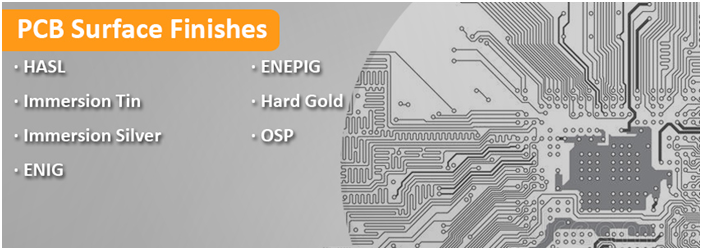
There are so many final surface finishes for choice in nowadays printed circuit board (PCB) fabrication. How do you decide which is the best? HASL, Immersion Tin, Immersion Silver, ENIG, OSP, ENIIPIG and Hard Gold are the primary surface finishes are widely used in PCB manufacturing.
- HASL stands for Hot Air Levelling, which is still one of the most popular surface finish choice. There are 2 types. One is with lead, and another is lead-free. We only manufacturing HASL PCBs with lead-free since environment protection. But in recent years, it has lost some of its shine because PCB manufacturers have realized its limitations. More complex products, higher level of integration, triggered the development of smaller components are the need for smaller traces, smaller pads and higher density PCBs. HASL lead-free leaves uneven surfaces that are not suitable for fine pitch components.
- Immersion Tin According to IPC, the Association Connecting Electronics Industry, Immersion Tin (ISn) is a metallic finish deposited by a chemical displacement reaction that is applied directly over the basis metal of the circuit board, that is, copper. The ISn protects the underlying copper from oxidation over its intended shelf life. Copper and tin however have a strong affinity for one another. The diffusion of one metal into the other will occur inevitably, directly impacting the shelf life of the deposit and the performance of the finish.
- Immersion Silver is an improvement on HASL being exceptionally flat, and can replace immersion gold over electroless nickel for most applications. The use of immersion silver has no effect on customer’s standard PCB assembly processes. Immersion Silver Metallic Solderability Preservative is a 0.1 to 0.2micron layer of metallic silver coated with an organic layer of solderability preservative.
- ENIG stands for Electroless Nickel Immersion Gold or Immersion Gold, or Chemical Gold, which has widely replaced “Flash Gold” (eletro), a finish was so widely used in 1990s in Asia. ENIG has become the surface finish of reference for multilayer PCBs and fine pitch PCB boards.
- OSP stands for Organic Solderability Preservative, or Entek, or passivation, is an organic finish that bond with copper. It is probably the most environmentally friendly surface finish, it requires little energy and no toxic materials are used.
- ENEPIG is a type of metal plating for PCBs. Developed around a decade ago, this kind of surface finish has gained popularity in recent years for its comparatively low cost to other types of gold plating for PCBs. Over the past several years, prices for palladium have substantially decreased compared to gold. By using palladium plating for PCBs instead of pure gold, PCB plating services can reduce plating costs, making ENEPIG a more popular electronic plating solution.
- Hard Gold Hard Electrolytic Gold consists of a layer of gold plated over a barrier coat of nickel. Hard gold is extremely durable, and is most commonly applied to high-wear areas such as edge connector fingers and keypads. Unlike ENIG, its thickness can vary by controlling the duration of the plating cycle, although the typical minimum values for fingers are 30µ” gold over 100µ” nickel for Class 1 and Class 2, 50µ” gold over 100µ” nickel for Class 3. Hard gold is not generally applied to solderable areas, because of its high cost and its relatively poor solderability. The maximum thickness that IPC standard considers to be solderable is 17.8µ”, so if this type of gold must be used on surfaces to be soldered, the recommended nominal thickness should be about 5-10µ”.
Common Surface Finish and Its Properties:
Lead-free HASL, ENIG and OSP are most widely used PCB surface finishes
| Properties | Lead-free HASL | Electroless Nickel Immersion Gold (ENIG) | Organic Solderable Coatings (OSP) |
| RoHS Compliant? | yes | yes | yes |
| Storage Life | 12 months | 12 months | 6 months |
| Experience reflow times | 4 | 4 | 4 |
| Cost | Medium | High | Low |
| Process complexity | High | High | Low |
| Process temperature | 240°C | 80°C | 40°C |
| Thickness range (?m) | 1-25 | Au: 0.05-0.2, Ni: 3-5 | 0.2-0.5 |